2022-10-11 • N-to-1 output rate (edit of ‘2022-05-02’)
Contents
2022-10-11 • N-to-1 output rate (edit of ‘2022-05-02’)¶
I found an ‘error’ in the N-to-1 code (used in 2022-05-02 • STA mean vs peak-to-peak amongst others): the ‘input per spike’ (Δg) is not scaled with the total number of inputs.
I.e, the more inputs, the stronger the one simulated neuron will spike.
The worry is that in the high-N cases, the output will be constantly firing, making connection detection via STA’s difficult (and that would be the reason for the observed poor performance in those cases).
So I went back in time (downloading old zips of repo and its submodules) and re-ran this notebook, to check/confirm this issue.
Conclusion:
The error was indeed there.
But the fear that the highest was drowning in spikes was not true. This is because the input in all the other cases (except N = 6400) was so low that the output did not spike at all.
The breakdown really is cause too much inputs, so the STAs become very noisy (SNR: ‘signal’ stays same (no downscaling of input with many N here (the ‘error’) – but noise goes up).
Setup¶
https://github.com/tfiers/phd/tree/da6bc5/pkg/VoltageToMap/src
] activate "../../phd-althist/da6bc5"
Activating project at `C:\Users\tfiers\phd-althist\da6bc5`
I instantiated old Manifest. Worked great.
] st
Status `C:\Users\tfiers\phd-althist\da6bc5\Project.toml`
⌃ [a93c6f00] DataFrames v1.3.2
⌃ [48062228] FilePathsBase v0.9.17
⌃ [7073ff75] IJulia v1.23.2
[54cd1024] MyToolbox v0.1.0 `pkg\MyToolbox`
⌃ [d330b81b] PyPlot v2.10.0
⌃ [295af30f] Revise v3.3.3
[61be95e5] Sciplotlib v0.1.0 `pkg\Sciplotlib`
[fd094767] Suppressor v0.2.1
⌃ [5d786b92] TerminalLoggers v0.1.5
[b3b8fdc5] VoltageToMap v0.1.0 `pkg\VoltageToMap`
[964570a8] WhatIsHappening v0.1.0 `pkg\WhatIsHappening`
Info Packages marked with ⌃ have new versions available
# using Revise
using MyToolbox
┌ Info: Precompiling MyToolbox [54cd1024-cafd-4d62-948d-ced4874502bf]
└ @ Base loading.jl:1662
using VoltageToMap
[ Info: Precompiling VoltageToMap [b3b8fdc5-3c26-4000-a0c8-f17415fdf48e]
using PyPlot
using VoltageToMap.Plot
[ Info: Precompiling PyPlot [d330b81b-6aea-500a-939a-2ce795aea3ee]
[ Info: Precompiling Sciplotlib [61be95e5-9550-4d5f-a203-92a5acbc3116]
Params¶
N_excs = [
4, # => N_inh = 1
17, # Same as in `previous_N_30_input`.
80,
320,
1280,
5200,
];
rngseeds = [0]; #, 1, 2, 3, 4];
get_params((N_exc, rngseed, STA_test_statistic)) = ExperimentParams(
sim = SimParams(
duration = 10 * minutes,
imaging = get_VI_params_for(cortical_RS, spike_SNR = Inf),
input = PoissonInputParams(; N_exc);
rngseed,
),
conntest = ConnTestParams(; STA_test_statistic, rngseed);
evaluation = EvaluationParams(; rngseed)
);
variableparams = collect(product(N_excs, rngseeds, ["ptp"])) #, "mean"]))
6×1×1 Array{Tuple{Int64, Int64, String}, 3}:
[:, :, 1] =
(4, 0, "ptp")
(17, 0, "ptp")
(80, 0, "ptp")
(320, 0, "ptp")
(1280, 0, "ptp")
(5200, 0, "ptp")
paramsets = get_params.(variableparams);
print(summary(paramsets))
6×1×1 Array{ExperimentParams, 3}
dumps(paramsets[1])
ExperimentParams
sim: SimParams
duration: 600.0
Δt: 0.0001
num_timesteps: 6000000
rngseed: 0
input: PoissonInputParams
N_unconn: 100
N_exc: 4
N_inh: 1
N_conn: 5
N: 105
spike_rates: LogNormal
μ: 1.08629
σ: 0.774597
synapses: SynapseParams
avg_stim_rate_exc: 1.0e-10
avg_stim_rate_inh: 4.0e-10
E_exc: 0.0
E_inh: -0.065
g_t0: 0.0
τ: 0.007
izh_neuron: IzhikevichParams
C: 1.0e-10
k: 7.0e-7
v_rest: -0.06
v_thr: -0.04
a: 30.0
b: -2.0e-9
v_peak: 0.035
v_reset: -0.05
Δu: 1.0e-10
v_t0: -0.06
u_t0: 0.0
imaging: VoltageImagingParams
spike_SNR: Inf
spike_SNR_dB: Inf
spike_height: 0.095
σ_noise: 0.0
conntest: ConnTestParams
STA_window_length: 0.1
num_shuffles: 100
STA_test_statistic: ptp
rngseed: 0
evaluation: EvaluationParams
α: 0.05
num_tested_neurons_per_group: 40
rngseed: 0
Run¶
# @edit cached(sim_and_eval, [paramsets[1]])
Note: the caching doesn’t work here between sessions: I still used wrong implementation with naive hash.
perfs = similar(paramsets, NamedTuple)
for i in eachindex(paramsets)
(N_exc, seed, STA_test_statistic) = variableparams[i]
paramset = paramsets[i]
println((; N_exc, seed, STA_test_statistic), " ", cachefilename(paramset))
perf = cached(sim_and_eval, [paramset])
println()
perfs[i] = perf
end
(N_exc = 4, seed = 0, STA_test_statistic = "ptp") d597e9845d59167c.jld2
Running simulation: 100%|███████████████████████████████| Time: 0:00:02
Saving output at `C:\Users\tfiers\.phdcache\sim\7ee3bb860249ab23.jld2` … done (11.2 s)
Testing connections: 100%|██████████████████████████████| Time: 0:00:07
Saving output at `C:\Users\tfiers\.phdcache\sim_and_eval\d597e9845d59167c.jld2` … done (0.9 s)
(N_exc = 17, seed = 0, STA_test_statistic = "ptp") 4375a8fd3d519fa2.jld2
Running simulation: 100%|███████████████████████████████| Time: 0:00:02
Saving output at `C:\Users\tfiers\.phdcache\sim\d4c4c08c9216be57.jld2` … done (2.2 s)
Testing connections: 100%|██████████████████████████████| Time: 0:00:10
Saving output at `C:\Users\tfiers\.phdcache\sim_and_eval\4375a8fd3d519fa2.jld2` … done
(N_exc = 80, seed = 0, STA_test_statistic = "ptp") 164a7233f370837b.jld2
Running simulation: 100%|███████████████████████████████| Time: 0:00:03
Saving output at `C:\Users\tfiers\.phdcache\sim\df4c33888513643b.jld2` … done (2.1 s)
Testing connections: 100%|██████████████████████████████| Time: 0:00:16
Saving output at `C:\Users\tfiers\.phdcache\sim_and_eval\164a7233f370837b.jld2` … done
(N_exc = 320, seed = 0, STA_test_statistic = "ptp") 96e074504cde04fc.jld2
Running simulation: 100%|███████████████████████████████| Time: 0:00:10
Saving output at `C:\Users\tfiers\.phdcache\sim\1d3d36db4ce3bc06.jld2` … done (2.2 s)
Testing connections: 100%|██████████████████████████████| Time: 0:00:20
Saving output at `C:\Users\tfiers\.phdcache\sim_and_eval\96e074504cde04fc.jld2` … done
(N_exc = 1280, seed = 0, STA_test_statistic = "ptp") 3b39418f81f46f30.jld2
Running simulation: 100%|███████████████████████████████| Time: 0:00:38
Saving output at `C:\Users\tfiers\.phdcache\sim\2b004720f7fc3850.jld2` … done (2.0 s)
Testing connections: 100%|██████████████████████████████| Time: 0:00:17
Saving output at `C:\Users\tfiers\.phdcache\sim_and_eval\3b39418f81f46f30.jld2` … done
(N_exc = 5200, seed = 0, STA_test_statistic = "ptp") 164cd3deb12bfdf8.jld2
Running simulation: 100%|███████████████████████████████| Time: 0:02:29
Saving output at `C:\Users\tfiers\.phdcache\sim\10badb65c823d91.jld2` … done (2.0 s)
Testing connections: 100%|██████████████████████████████| Time: 0:00:10
Saving output at `C:\Users\tfiers\.phdcache\sim_and_eval\164cd3deb12bfdf8.jld2` … done
perfs
6×1×1 Array{NamedTuple, 3}:
[:, :, 1] =
(TPR_exc = 1.0, TPR_inh = 1.0, FPR = 0.0)
(TPR_exc = 1.0, TPR_inh = 1.0, FPR = 0.050000000000000044)
(TPR_exc = 1.0, TPR_inh = 1.0, FPR = 0.050000000000000044)
(TPR_exc = 1.0, TPR_inh = 0.725, FPR = 0.050000000000000044)
(TPR_exc = 0.775, TPR_inh = 0.5, FPR = 0.09999999999999998)
(TPR_exc = 0.075, TPR_inh = 0.075, FPR = 0.09999999999999998)
(Addon)¶
using Printf
Base.show(io::IO, x::Float64) = @printf io "%.4g" x
1/3
0.3333
Check if output rate increases¶
Hah there was not even output spike recording. Oops.
I’ll detect manually.
function f(p)
s = cached(sim, [p.sim]);
ot = s.v .> p.sim.izh_neuron.v_thr # over thr
spike_ix = findall(diff(ot) .== +1) # pos thr crossings
spiketimes = spike_ix * p.sim.Δt
num_spikes = length(spiketimes)
spike_rate = num_spikes / p.sim.duration * Hz
time_between = 1/spike_rate * seconds
return (; N_conn = p.sim.input.N_conn, num_spikes, spike_rate, time_between)
end
for p in paramsets
println(f(p))
end
(N_conn = 5, num_spikes = 0, spike_rate = 0, time_between = Inf)
(N_conn = 21, num_spikes = 0, spike_rate = 0, time_between = Inf)
(N_conn = 100, num_spikes = 0, spike_rate = 0, time_between = Inf)
(N_conn = 400, num_spikes = 0, spike_rate = 0, time_between = Inf)
(N_conn = 1600, num_spikes = 0, spike_rate = 0, time_between = Inf)
(N_conn = 6500, num_spikes = 95, spike_rate = 0.158, time_between = 6.32)
Ok. So the fear that the highest was drowning in spikes was not true. The breakdown really is cause too much inputs, so signal is less clear.
Plot¶
(Just the figure output, copied from older nb)
Peak-to-peak¶
fig, ax = make_figure(perfs[:,:,1]);
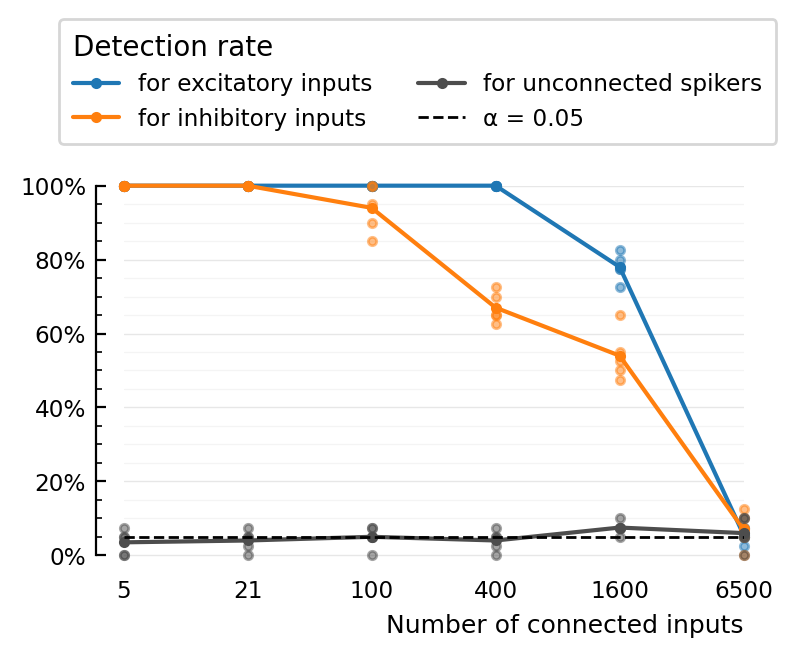
Inputs’ Firing rates distribution¶
I want to check something else suspicious.
In this nb (a bit earlier), input firing rates are sampled from a LogNormal distr. But looking at this plot here: https://tfiers.github.io/phd/nb/2022-03-28__total_stimulation.html#total-stimulation – where “total stimulation” is directly proportional to num spikes (every inh neuron has same Δg) – the fr distributions look very un-lognormal to me..
p = paramsets[end]
p.sim.input.N_conn
6500
p.sim.input.spike_rates
LogNormal{Float64}(μ=1.09, σ=0.775)
(Real mean of that is 4Hz).
s = cached(sim, [p.sim]);
mean_ISI = [d.θ for d in s.state.fixed_at_init.ISI_distributions] # scale = β = θ = mean
plt.hist(mean_ISI / seconds, bins=20);
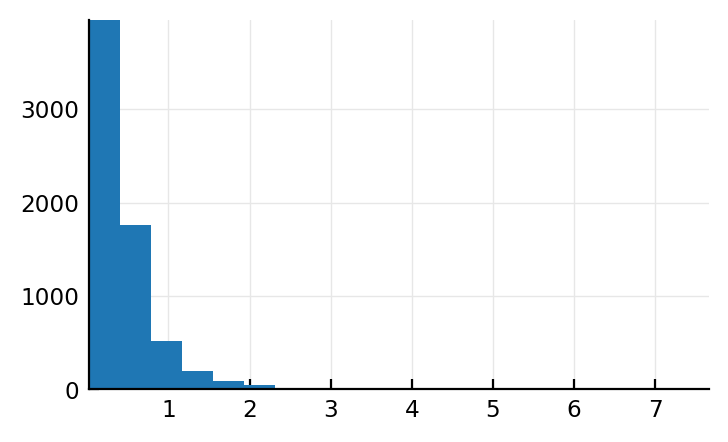
mean_spikes_per_sec = 1 ./ mean_ISI # λ = rate
plt.hist(mean_spikes_per_sec / Hz, bins=20);
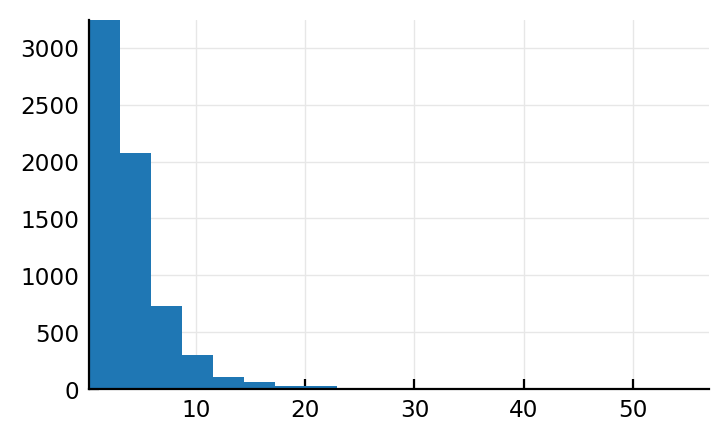
Ok that’s not Normal, good
num_spikes = length.(s.input_spikes)
plt.hist(num_spikes);
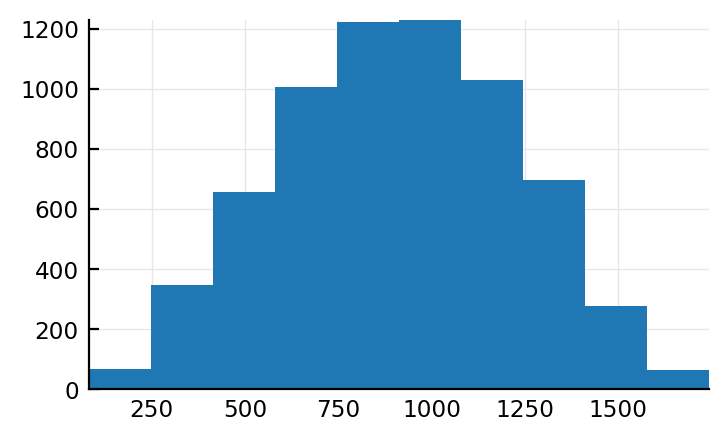
.. and that is.
I must have made a reasoning error somewhere. Or a programming error (all sampled from same distr or sth).
@unpack ISI_distributions, = s.state.fixed_at_init;
findmax(mean_spikes_per_sec)
(56.98, 1862)
findmin(mean_spikes_per_sec)
(0.1305, 2613)
some_ISIs = rand(ISI_distributions[1862], 3) / ms |> show
[6.734, 0.3597, 5.217]
some_ISIs = rand(ISI_distributions[2613], 3) / ms |> show
[8215, 9845, 1695]
Ok, that’s all good.
So why do these input spikes look normal.
Let’s simulate ourselves, again.
spikes = Dict()
for (n, ISI_distr) in enumerate(ISI_distributions[1:1000])
t = 0.0
spikes[n] = Float64[]
while true
t += rand(ISI_distr)
if t ≥ p.sim.duration
break
end
push!(spikes[n], t)
end
end
num_spikes = length.(values(spikes))
plt.hist(num_spikes);
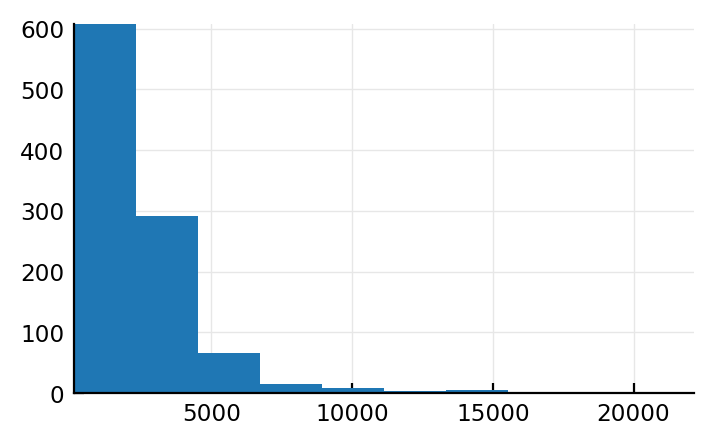
Akkerdjie. Dit is wel lognormal.
What’s diff with sim code.
function simstep(spikerec, upcoming_input_spikes, ISI_distributions, t)
t_next_input_spike = peek(upcoming_input_spikes).second # (.first is neuron ID).
if t ≥ t_next_input_spike
n = dequeue!(upcoming_input_spikes) # ID of the fired input neuron
push!(spikerec[n], t)
tn = t + rand(ISI_distributions[n]) # Next spike time for the fired neuron
enqueue!(upcoming_input_spikes, n => tn)
end
end
input_neuron_IDs = CVec(collect(1:length(ISI_distributions)), getaxes(ISI_distributions))
@unpack upcoming_input_spikes = s.state.variable_in_time;
first_input_spike_times = rand.(ISI_distributions)
spikerec = Dict{Int, Vector{Float64}}()
empty!(upcoming_input_spikes)
for (n, t) in zip(input_neuron_IDs, first_input_spike_times)
enqueue!(upcoming_input_spikes, n => t)
spikerec[n] = []
end
# duration = p.sim.duration
duration = 1minutes
@showprogress for t in linspace(0, duration, round(Int, duration / p.sim.Δt))
simstep(spikerec, upcoming_input_spikes, ISI_distributions, t)
end
Progress: 100%|█████████████████████████████████████████| Time: 0:00:01
num_spikes = length.(values(spikes))
spikerates = num_spikes ./ duration
plt.hist(spikerates);
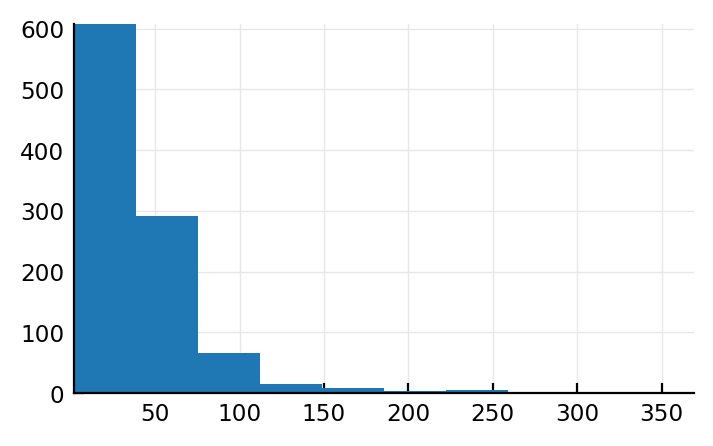
(Note that here we sim for all inputs but not all time; in previous plot we sim’ed for all time but not all inputs).
Ma huh?
This is almost exactly the code in step_sim!
@less VoltageToMap.step_sim!(s, p.sim, [], 1)
function step_sim!(state, params::SimParams, rec, i)
@unpack ISI_distributions, postsynapses, Δg, E = state.fixed_at_init
@unpack vars, diff, upcoming_input_spikes = state.variable_in_time
@unpack t, v, u, g = vars
@unpack Δt, synapses, izh_neuron = params
@unpack C, k, v_rest, v_thr, a, b, v_peak, v_reset, Δu = izh_neuron
# Sum synaptic currents
I_s = zero(u)
for (gi, Ei) in zip(g, E)
I_s += gi * (v - Ei)
end
# Differential equations
diff.v = (k * (v - v_rest) * (v - v_thr) - u - I_s) / C
diff.u = a * (b * (v - v_rest) - u)
for i in eachindex(g)
diff.g[i] = -g[i] / synapses.τ
end
# Euler integration
@. vars += diff * Δt
# Izhikevich neuron spiking threshold
if v ≥ v_peak
vars.v = v_reset
vars.u += Δu
end
# Record membrane voltage
rec.v[i] = v
# Input spikes
t_next_input_spike = peek(upcoming_input_spikes).second # (.first is neuron ID).
if t ≥ t_next_input_spike
n = dequeue!(upcoming_input_spikes) # ID of the fired input neuron
push!(rec.input_spikes[n], t)
for s in postsynapses[n]
g[s] += Δg[s]
end
tn = t + rand(ISI_distributions[n]) # Next spike time for the fired neuron
enqueue!(upcoming_input_spikes, n => tn)
end
# Unhandled edge case: multiple spikes in the same time bin get processed with
# increasing delay. (This problem goes away when using diffeq.jl, `adaptive`).
end
(https://github.com/tfiers/phd/blob/da6bc5b/pkg/VoltageToMap/src/sim/step.jl)
mean_ISIs_sim = mean.(VoltageToMap.to_ISIs.(s.input_spikes))
plt.hist(mean_ISIs_sim / seconds, bins=20);
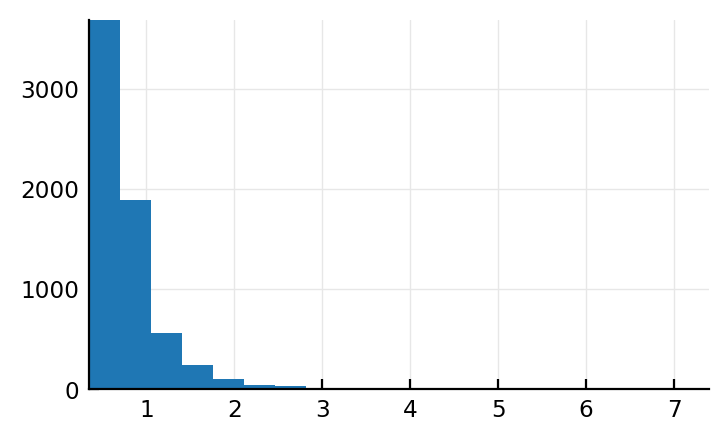
Wait what. The mean ISI distr does look lognormal i.e. correct.
Then why doesn’t the rate distr?
plt.hist(length.(s.input_spikes) / p.sim.duration / Hz, bins=20);
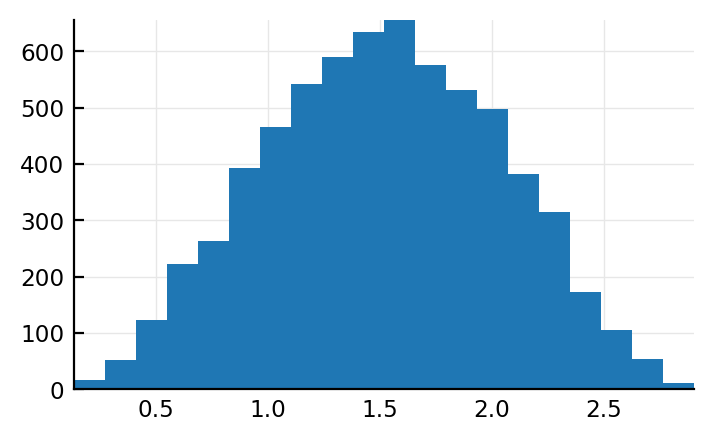
Let’s investigate two concrete neurons.
findmin(mean_ISIs_sim), findmax(mean_ISIs_sim)
((0.3444, 1862), (7.393, 5513))
length(s.input_spikes[1862]), length(s.input_spikes[5513])
(1742, 81)
Wut. (This is a great, expected spread).
1742/10minutes, 81/10minutes
(2.903, 0.135)
Ok so the normal diagram has correct values.
How does a normal simulated fr distr arise from lognormal mean ISIs.